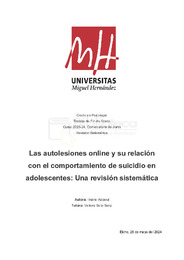Resumen :
El suicidio es una de las causas principales de muerte entre los adolescentes y
jóvenes adultos. Este acto se produce por la interacción de varios factores
sociodemográficos, factores psicológicos, factores biológicos y factores sociales y
ambientales. Una variable que ha surgido y se está estudiando recientemente son “las
autolesiones online” que consiste en enviar o publicar de forma anónima, a través de las
tecnologías de la información y comunicación, comentarios negativos sobre uno mismo. De
manera que, el objetivo de este estudio es sintetizar la información de la literatura existente
sobre las autolesiones online y su relación con los factores de riesgo asociados al
comportamiento de suicidio en adolescentes de entre 12 y 19 años. Para la elaboración de
la presente revisión se siguieron los criterios de la guía PRISMA y de la pregunta PICO. Se
seleccionaron 8 artículos de las bases de datos Scopus y PubMed y las palabras claves que
se utilizaron fueron “digital AND self-harm”, “digital AND self-harm AND adolescents” y
“digital AND self-harm AND suicide”. Los resultados reflejaron una relación positiva entre las
autolesiones online y los diferentes factores de riesgo asociados al comportamiento suicida.
El 62,5% de los artículos seleccionados reflejaron una relación entre las autolesiones online
y los síntomas de depresión y la relación familiar, el 37,5% reflejaron una relación entre las
autolesiones online y ser víctima de acoso escolar y ciberacoso y emociones negativas, el
25% reflejaron una relación entre las autolesiones online y la ansiedad, ideación suicida e
intentos de suicidio. En conclusión, es necesario prestar más atención a esta variable para
poder incorporarla en los planes de prevención e intervención del comportamiento de
suicidio en esta población.
Suicide is one of the main causes of death among adolescents and young adults.
This act occurs by the interaction of various sociodemographic factors, psychological factors,
biological factors, and social and environmental factors. A variant that has emerged and it’s
being studied recently is “digital self-harm”, which consists in anonymously, through the
information and communication technology, sending and posting negative comments about
one’s self. So that the aim is to synthesize the existing literature about digital self-harm and
its relationship with the risk factors that are associated to suicidal behavior among
adolescents aged 12 to 19 years. For the development of the present review, it has been
done by following the PRISMA guidelines and the question PICO criteria. 8 articles have
been selected from the databases Scopus and PubMed and the key words that have been used were “digital AND self-harm”, “digital AND self-harm AND adolescents” y “digital AND
self-harm AND suicide”. The finding results have shown a positive relationship between
digital self-harm and the different risk factors associated to suicidal behavior. The 62,5% of
selected studies reflected a relationship between digital self-harm and depressive symptoms
and family relationship, the 37,5% reflected a relationship between digital self-harm and
bullying and cyberbullying victimization and negative emotions, the 25% reflected a
relationship between digital self-harm and anxiety and suicide ideation and attempts. In
conclusion, it is crucial to pay more attention to this issue and address it by implementing
necessary measures to intervene and prevent this problem.
|
 La licencia se describe como: Atribución-NonComercial-NoDerivada 4.0 Internacional.
La licencia se describe como: Atribución-NonComercial-NoDerivada 4.0 Internacional.
.png)
